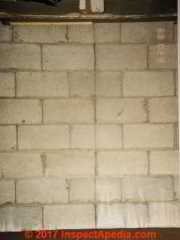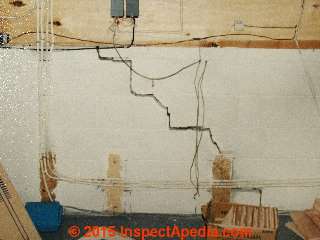 Block Foundation Wall Damage FAQs
Block Foundation Wall Damage FAQs
- POST a QUESTION or COMMENT about damaged concrete block foundations: causes, crack & movement patterns, diagnosis, repair, inspection procedures
Q&A on damaged masonry block foundations & walls:
Frequently-asked questions about the diagnosis & repair of damaged masonry block foundations & walls.
This article series explains the types of foundation cracks, crack patterns, differences in the meaning of cracks in different foundation materials, site conditions, building history, and other evidence of building movement and damage.
Types of foundation damage are described to assist in recognizing foundation defects and to help the inspector separate cosmetic or low-risk conditions from those likely to be important and potentially costly to repair.
InspectAPedia tolerates no conflicts of interest. We have no relationship with advertisers, products, or services discussed at this website.
Questions & Answers on Masonry Block (concrete & "cinder block") Foundation & Wall Damage
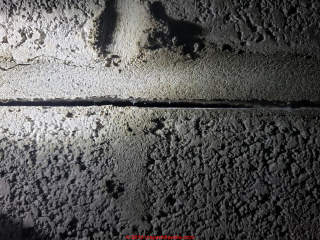 These questions and answers about how to evaluate the type and extent of damage to a concrete block wall or foundation ("cinder blocks" or "masonry blocks") were posted originally at BLOCK FOUNDATION & WALL DEFECTS - home - be sure to review that article.
These questions and answers about how to evaluate the type and extent of damage to a concrete block wall or foundation ("cinder blocks" or "masonry blocks") were posted originally at BLOCK FOUNDATION & WALL DEFECTS - home - be sure to review that article.
On 2019-04-27 - by (mod) - water entry in a home under construction
Glad to assist - keep in mind that nobody can "inspect" conditions just by text; so there's likely to be more to be observed and understood on-site.
Keep me posted, post photos if you can.
On 2019-04-27 by Chuck
Thank you for the feedback. Looks like I have my work cut out for me with regard to addressing these issues AND issues with my builder. Your feedback has proved invaluable if simply by guiding me to look into it further.
Thanks, Chuck
On 2019-04-26 1 - by (mod) -
Chuck
I'm with you on this. You already have water coming in and backfill is in place.
If the contractor expects to fix this problem from the inside that's a poor approach and one not without drawbacks - "let the water in and then get rid of it" is never as effective as preventing water entry in the first place.
IMO there is no alternative that's a good one except to remove the backfill and install proper foundation drainage; houses are not normally built to be boats.
I am worried about this builder. This is an early sign of trouble. Get your tolerance and policies and payment schedules clear now or expect worse trouble later on.
To be fair the ONLY case in which water entry doesn't worry me in new construction is water entry before dry-in - before the roof and walls are weather tight and water enters through those openings in rainy weather, and on occasion when roof spillage around the foundation sends water into a basement or crawl space BEFORE foundation drainage is in place and of course before there are gutters and downspouts.
But once the backfill is in place the home is already demonstrating that roof spillage is or surface runoff are going to be a problem.
Use the Add Image button to post some photos - 1 per comment - of the outside and inside of the home and we may be able to add more-useful observations.
On 2019-04-26 by Chuck
We are having a new home built and three sides of the basement cinder block walls have water coming through and salt stains from water coming through previously.
The house is not completely built yet. The framing a roof are in place and the contractor has pushed dirt up against the cinder block foundation on these three sides (fourth side is a daylight basement) to just below the level of the black sealant and 1/2 - 1 inch covering material (looks like a fiber or insulation board of some kind and goes all the way to the bottom of the foundation.
Although the final landscaping is not complete, I expressed my concern to the contractor that there is water showing through the cinderblock walls and also salt stain from previous water coming through. His response was "Don't worry; they (the company who sealed it) guarantee their work".
If there's a problem, I'd rather recognize and repair it now rather than later when I'd have to have the dirt and landscaping dug away from the cinder blocks. Should I be concerned now or is this a common occurrence with new construction?
On 2019-10-29 by (mod) -
Sealing those cracks is a perfectly reasonable thing to do.
You might also take a look in your basement or you will be able to see whether they're actually has been a history of water entry in that location.
Watch out: I cannot tell where this buckled wall crack is (except that it's near the top of your foundation wall) in relation to the concrete patio or walk shown in some of your photos.
If the crack is at the same location as a concrete walk or patio that walk or patio may be settling (due to imroper backfill or construction on loose soil or due to excessive roof spillage or surface runoff in that area)
On 2019-10-28 by Cory
Should these cracks be sealed with mortar filler to avoid moisture coming into the basement?
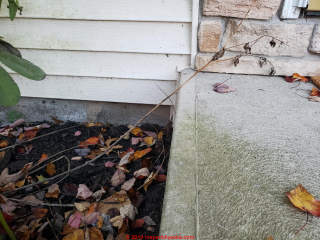
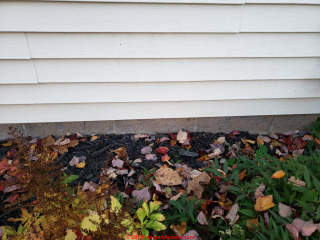
On 2019-10-28 by Cory
Thank you for your quick response. Unfortunately that part of the foundation appears to be underneath a concrete porch. I took a picture and will comment solely to post several more of the crack and the sides of the porch where you can see the foundation, but it is mostly parged.
On 2019-10-28 by (mod) - wavy mortar characteristic of wall loading damage during construction - before mortar has set
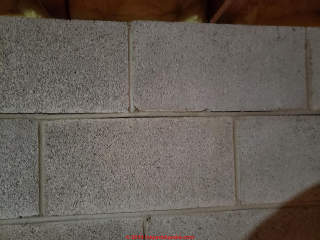 Cory,
Cory,
I'd like to see this foundation from outside. I suspect that that to course of block and that first mortar joint down is close to the top of the finish grade.
If I'm right then that looks like backfill damage that occurred at the time of construction.
See details at BLOCK FOUNDATION BACKFILL DAMAGE
As long as there is no other foundation damage or movement you
- should be sure to prevent frost damage (if you live in a freezing climate) by directing water and roof runoff away from the foundation, or mechanical damage (from vehicles driving right along the wall)
On 2019-10-28 by Cory
Hello,
I recently bought a 20 year old home with a block basement. Upon examining the walls I discovered some horizontal cracks in the mortar joints that I was going to repair.
However, when examining the mortar joints I discovered that they actually appear to be separations from the block rather than cracks. When looking into the separations it is apparent that the mortar is seperated quite far back into the block.
These separations have occurred at above grade level. I also have some small horizontal cracking in mortar joints below grade.
I diligently measured the walls using a plumb line and method described on your site and found a deviation no greater than .25 inches.
That deviation occured near the top of the wall and the measurement was less to the plumb line at the top of the wall than at the bottom.
I would like your input into the possible causes of the cracks and the suggested repair of the mortar joints. Thank you.
On 2019-05-04 by (mod) -
Before planning a repair you need to understand whether it's structural concern or just cosmetic. The concern is only cosmetic, that is if your wall is not structural, you may be able to purge it with a combination of metal lath for reinforcements and concrete stucco.
On 2019-05-03 by Lee Morgans
My wife has hit my drive way block wall which now has a lot of cracks in it. Please can somebody recommend a material to fix it?
On 2019-03-2 by (mod) -
Kyule
You need an on site expert to examine the footings for the foundation wall to see what's going on: it looks as if the footings are rotating or leaning or tipping; the causes could be improper original construction, placement on soft fill, omission of adequate re-bar, or something else.
On 2019-03-21 by Kyle
New construction custom home in west central indiana. Footers poured and blocks laid late fall. Had plenty of precipitation throughout winter with 2 hard freezes. See attached photo for damage. Several corners of foundation has same damage and a few blocks here and there in middle of straight runs.
Trying to decide what the correct course of action is
IMAGE LOST by older version of Clark Van Oyen’s useful Comments code - now fixed. Please re-post the image if you can. Sorry. Mod.
On 2018-11-19 by John Kevin Barbour
What should I worry about with this issue? Who should I contact?
There is a long separation in the back wall. Inward bow is barely noticeable, we have had unusually wet weather and basement flooding. Oh, see image.
Can I use my insurance for this?
IMAGE LOST by older version of Clark Van Oyen’s useful Comments code - now fixed. Please re-post the image if you can. Sorry. Mod.
On 2018-10-12 by (mod) -
Joan
Losing surface material, or "spalling" on concrete blocks may mean damage from water, rain splash-up (roof spillage), frost, combined with older or soft low-concrete mix when the blocks were made
Cracking is a different matter: the size, shape, position, length, width, pattern of cracking along with total extent of movement are evaluated to decide what kind of repair is needed. In extreme cases such as a wall leaning in 3" or more at the top or bulged in center, there is risk of collapse and you need more-urgent evaluation and help.
You might try calling an experienced mason who is familiar with block construction.
You can also add an image to a comment to show us what you see.
On 2018-10-12 by JoAN
We have a cinder block house that is showing cracks, come sloughing off of "concrete" -
Who can we call to fix it? Is there a temporary fix we can do before winter and finding
a professional?
On 2017-08-31 by (mod) - diagnose the cause of vertical cracks in block walls
There can be several causes for vertical cracking in foundation walls, all typically a form of settlement, and rarely a form of shrinkage - but footing or foundation wall settlement itself stems from varying causes such as improper site preparation, defective footings, water, expansive clay soil and more.
See these two articles to read details
On 2017-09-18 by Dan
What causes cracks in your cinder block wall from your foundation up on the front wall and back side wall
On 2017-09-06 by Ron davig
The block wall '8ft' on lower side of attached garage appears to have separated from garage concrete slab about 1". House built in 1970. Is this a structural problem that needs fixing? Thanks.
On 2017-08-31 by (mod) - pushed wall in probably 6 inches
MIke:
When there is that much (6") dislocation in a block wall there is risk of wall collapse. While you could and perhaps should set up some emergency bracing or posts inside to protect the structure (dont' know, can't see it), most-likely you'll have to
- set up temporary beam and posts to support the garage from inside and back from the wall enough to give working space
- remove the damaged wall
- reconstruct a new wall using adequate outside drainage and including sufficient reinforcement (probably vertical steel rebar and concrete) to avoid being pushed in again
- backfill the repaired wall after drainage has been installed
- slope the grade with a swale to keep surface runoff away from the wall
Use the page top or bottom CONTACT link to send me photos of the situation and I might be able to offer added comments. You would perhaps be best off with an onsite expert masonry contractor or engineer who is familiar with residential masonry failures who can offer added advice.
On 2017-08-30 by Mike knapik
The garage was built into hillside. lack of proper sloping and draining has pushed wall in probably 6 inches. Now what ?
On 2017-05-02 by Sharney
Hi, our house is 17 years old. The bottom brick on each corner of the outside of the house is cracking, with one of the bottom bricks starting to break away. The house is built on a slab. There are no cracks on walls inside the house etc. Is this something that needs looking at urgently?
On 2017-04-25 by (mod) -
Mark
I don't blame you for wanting to understand what's going on, what is the cause, what's the extent of damage; I can't guess without knowing more about the situation; perhaps you can send us some photos using the page top or bottom CONTACT link;
If you see the foundation wall is leaning, bulged, bowing, then there is a more likely serious condition and you'll need an onsite expert mason or engineer.
On 2017-04-25 by Mark
Hi,
We are very concerned that a cinder block fell loose on our HVAC duct located in the crawlspace. Our house is only 3 years old. What would cause this to happen? Is the structural integrity of the foundation compromised? How should this be repairs? Any help would be greatly appreciated!!! (I tried to attach a photo but it did not work)
On 2017-04-07 by (mod) -
Cement suppliers who specify a maximum temperature range for working concrete specify temperatures from 80 to 95 degrees. Chances are you'll be okay but you may need to be sure that the surface to which you are applying the parging has been wet.
On 2017-04-07 by Betty
Can you parge in 90 degree weather ?
On 2017-02-1 by (mod) -
Breezi
You will want to hire a foundation contractor with experience in foundation repair. Unlike the great Carno I can't quite see, from here in Mexico, the condition of your foundation nor how your home is constructed.
But in general the contractor will install one or more horizontal beams supported by posts to support the structure from below over a sufficient expanse that the damaged foundation section can be removed and re-built. Jacking is kept to an absolute minimum, lest you break other building components. -
Search InspectApedia (using the Search box just above) for FOUNDATION REPAIR METHODS to read more details.
On 2017-02-16 by Breezi
I have an older home build In 1910 that has a cement block foundation that has collapsed severely on one side due to a tree root. Any suggestion on how to go about jacking it up and fixing the wall?
On 2017-02-16 by (mod): how to repair tree root damage to a concrete block foundation
Breezi
You will want to hire a foundation contractor with experience in foundation repair. Unlike the great Carno I can't quite see, from here in Mexico, the condition of your foundation nor how your home is constructed.
But in general the contractor will install one or more horizontal beams supported by posts to support the structure from below over a sufficient expanse that the damaged foundation section can be removed and re-built.
Jacking up the building is kept to an absolute minimum, lest you break other building components. -
Search InspectApedia (using the Search box just above) for FOUNDATION REPAIR METHODS to read more details.
Or see FOUNDATION DAMAGE & REPAIR GUIDE - home.
On 2017-02-16 by Breezi
I have an older home build In 1910 that has a cement block foundation that has collapsed severely on one side due to a tree root. Any suggestion on how to go about jacking it up and fixing the wall?On 2017-02-06 b (mod)
Tony: if the foundation is sound and the damage is to isolated blocks I'd consider removing loose material, applying a bonding agent, then repairing with a masonry patch concrete that you can stain or color to match the original.
On 2017-02-06 by Tony
I have a 15 foot high block wallmade with the red designer blocks. A couple are crumbling and I don't know how to fix them. Help?On 2016-11-10 by (mod) - foundation coatings using Hydro-Seal 75 waterproofing
Thanks Rick for the clandestine ad along with installation tips for this waterproof coating product.Warning to readers: some, perhaps many coatings will be pushed off of the interior wall surface if you do not also get water away from the building exterior.
On 2016-11-10 by Rick Bernard
When applying Hydro-Seal 75 waterproof coating to basement walls and floors we run into cracked and spalling concrete surfaces all the time.
1. Remover all loose concrete with wire brush and chisel.
2. Apply coat of Hydro-Seal 75 with paint brush to act as a bonding agent for patching mortar
3. Apply Hydro-Seal 75 Mortar made from Hydro-Seal 75 Portland Cement & Sand applied with putty knife or trowel on large resurfacing areas.
4. Apply Hydro-Seal 75 over entire surface with brushes and rollers
On 2016-09-14 by (mod)
Bill:
Why not invite your neighbor to stand there and watch your wall. Start with a clean dry wall and then have an accomplice pour water on the neighbors side.
Let your neighbor watch the water coming through the wall. At that point your neighbor can see what any normal fair-minded person would acknowledge that if you pour water on one side of a concrete block wall it's going to come through on the other side.
S. Danahy.
Use the page Bottom CONTACT link to send me some sharp photos and we can comment further.
On 2016-09-14 by S Danahy
My cinder blocks(1976) on the one corner of my house seems to be flaking or scaling in planes, professionals are trying to sell me a foundation kit however there is no symptoms in the frames, Windows & doors showing any signs, as well as the exterior & interior walls.
They want just over $18000.please your input would be more knowledge.
S.Danahy
On 2016-09-09 by Bill
I have a common cinder block wall,shared with a neighbor. He has a planter on his side, with 8-10 inches of soil against the wall. when he waters the planter the water LEACHES into the wall and is causing damage.
He denies any responsibily. Need literature or help with proving my case
On 2016-09-08 by (mod)
I could use some of that physical persuasion power - to improve communications with a couple of fellows who steal our website traffic by swiping our content and images, thus carrying off the pittance of an income that permits InspectApedia to give away information to anybody who wants it.On 2016-09-08 by Anonymous
Cheers moderator, I will check the search description you have recommended.
Still I might tell people it's caused by my punching power :)
On 2016-09-07 by (mod) Pounding a punching bag causes foundation wall damage?
Mick,
I'm not sure what's meant by breeze block walls; vertical cracks in masonry walls often mean that there has been settlement in the wall footing.
You may be a heck of a guy who packs a whale of a punch, but I'd be surprised if hitting a punching bag would cause foundation settlement or cracking.
Search InspectApedia for VERTICAL MOVEMENT IN FOUNDATIONS to read details.
Just covering a crack with cement won't stop the cracks from recurring if there is settlement going on.
On 2016-09-07 by Mick Fenton
Hi I have cracks running vertically through the cemented corners to the breeze block walls in my garage, not sure if these are serious and what caused them.
I do have a punching bag hanging from the timbered roof of the garage and was wondering if this has caused the cracking and whether just covering with more cement would cure it?
Any help would be gratefully received.
Mick
On 2016-07-29 by (mod) chipping falling concrete block, with stairstep cracks
Connie, I cannot guess how serious is chipping or cracking block from your e-text; It depends on the size, location, cause of cracking, the amount of movement and thus its impact on the structure.
Certainly I'd be surprised if installing a starter strip for siding would cause structural damage to a building;
Similarly I'd be surprised if drilling a 1/4" hole to pass a cable into a building could cause structural damage. More likely something else is going on.
On 2016-07-28 by Connie c
Hi, we just moved into a well built brick house with a block basement. We had a tv satellite company to hook us up to a dish and they drilled a hole through our block foundation for the cable. We now have several cracks in our block. Some are stair stepped and some go through the block.
And there is some chipping and falling pieces of block. How serious is this? Thanks. Connie
On 2016-07-27 by Bill Coulter
Seven years ago my Townhome Association replaced our siding. They attached a 6" cedar strip as a starting point for applying the siding.
Over time alot of my neighbors have noticed the foundation block where the board was attached show signs of the concrete block deteriorating, I have found indications that in attaching these strips nails were driven into the concrete blocks. Could this be a contributing factor to the block deteriorating?
On 2016-07-26 by (mod) water-main flood damaged foundation wall - is there a collapse risk?
Ken,
I can't buy enough insurance to promise, based on a mere e-text question, that someone's house is safe from collapse nor much else.
Your lawyer, being a lawyer, would enjoy litigation, so is willing to do research for you that more properly, and more sensibly, would be decided by an on-site expert who knows foundations, old types of masonry block, and structural failures.
This might be a licensed professional engineer IF she/he has experience in these specific areas.
Some masons and even some home inspectors might also have the right experience and background to assess your foundation.
I can offer a general remark that if the block has retained its hardness, position, surface texture, then it's likely to not be showing signs of structural failure. If it's crushing, crumbling, leaning, bending, bowing, bulging, or if you can poke a hole in it with your finger or a screwdriver, it's rather unreliable and could be unsafe.
I'd also worry about the other effects of water or moisture on your building: mold, insect damage, rot.
On 2016-07-26 by Ken barrett
My basement is ash cinderblock from the 1950's. A 36" water main broke in the woods behind my house and eventually flooded me 7 times over a year..the block is severely discolored, black ,gray ..it is my back wall supporting my house..is there danger of collapse because it is "ash cinder?
My lawyer says he cannot find any information on ash cinderblock exposed to long term water damage..PLEASE HELP!! THANK YOU.
MY EMAIL..kenbarrett67@gmail
.com..
On 2016-05-24 9 by Charles
in the corner of the foundation on lower row of 12" cement blocks there is one broken cement block, with about 80% of the block gone.
I'm not sure how this happened but I'm trying to get the best method for fixing it.
Is this a repair that I can do myself or do I need to contact a foundation contractor.
On 2016-04-12 by (mod) horizontal cracks in a foundation deserve careful examination
Horizontal cracking in a concrete block wall is more likely to be caused by earth pressure than a sinkhole.
I suggest that you ask for an evaluation by an experienced mason or by a structural or civil engineer who has familiarity with residential foundation repair.
On 2016-04-10 by JMCFLA
My house has a lower horizontal crack that turns into steps. It was small and has now (over 3 weeks) grown to go across the entire outside wall in 3 different sections at the same level, all of which have a long horizontal look then stairs with each of them.
I am afraid of sinkholes here in florida and wonder if that is what is causing these (a sinkhole under the bedroom) at that wall. Could it be something else? Thank you!!
On 2016-02-02 by David
If my cinder block foundation (crawl space) has an outline the shape of a rectangle on its outside face, does that mean moisture is building up behind it and wicking through?On 2016-01-29 by Joe
Need reason for house length cinderblock separation, for insurance to repairOn 2015-08-19 by (mod) mold cleanup before foundation repair?
Anon:If building interior surfaces, ceilings, insulation, were wet it would make sense to remove wet materials that cannot be cleaned and dried - including insulation, and to be alert for visible mold or building IAQ complaints.
On 2015-08-19 by Anonymous
if a buildings ceiling falls in in the winter time and is not fixed for a long period of time should they look for black mold before putting on a new roof.
Also some of the installation was removed but not all of it. Can black mold come about because of them neglecting them to check the ceiling first?
...
Continue reading at BLOCK FOUNDATION & WALL DEFECTS or select a topic from the closely-related articles below, or see the complete ARTICLE INDEX.
Or see BLOCK FOUNDATION WALL DAMAGE FAQs-2 - more-recent questions and answers about cracked or damaged concrete block walls or foundations.
Or see these
Recommended Articles
- BLOCK FOUNDATION & WALL DEFECTS - home
- BLOCK WALL INSULATION RETROFIT
- CONCRETE or MASONRY DAMAGE TESTS
- FOUNDATION CRACK DICTIONARY for descriptions of different crack patterns, causes, repairs
- FOUNDATION DAMAGE & REPAIR GUIDE - home
- FOUNDATION DAMAGE SEVERITY
- FOUNDATION INSPECTION STANDARDS
Suggested citation for this web page
BLOCK FOUNDATION WALL DAMAGE FAQs at InspectApedia.com - online encyclopedia of building & environmental inspection, testing, diagnosis, repair, & problem prevention advice.
Or see this
INDEX to RELATED ARTICLES: ARTICLE INDEX to BUILDING STRUCTURES
Or use the SEARCH BOX found below to Ask a Question or Search InspectApedia
Ask a Question or Search InspectApedia
Questions & answers or comments about damaged concrete block foundations: causes, crack & movement patterns, diagnosis, repair, inspection procedures..
Try the search box just below, or if you prefer, post a question or comment in the Comments box below and we will respond promptly.
Search the InspectApedia website
Note: appearance of your Comment below may be delayed: if your comment contains an image, photograph, web link, or text that looks to the software as if it might be a web link, your posting will appear after it has been approved by a moderator. Apologies for the delay.
Only one image can be added per comment but you can post as many comments, and therefore images, as you like.
You will not receive a notification when a response to your question has been posted.
Please bookmark this page to make it easy for you to check back for our response.
Our Comment Box is provided by Countable Web Productions countable.ca
Citations & References
In addition to any citations in the article above, a full list is available on request.
- In addition to citations & references found in this article, see the research citations given at the end of the related articles found at our suggested
CONTINUE READING or RECOMMENDED ARTICLES.
- Carson, Dunlop & Associates Ltd., 120 Carlton Street Suite 407, Toronto ON M5A 4K2. Tel: (416) 964-9415 1-800-268-7070 Email: info@carsondunlop.com. Alan Carson is a past president of ASHI, the American Society of Home Inspectors.
Thanks to Alan Carson and Bob Dunlop, for permission for InspectAPedia to use text excerpts from The HOME REFERENCE BOOK - the Encyclopedia of Homes and to use illustrations from The ILLUSTRATED HOME .
Carson Dunlop Associates provides extensive home inspection education and report writing material. In gratitude we provide links to tsome Carson Dunlop Associates products and services.



